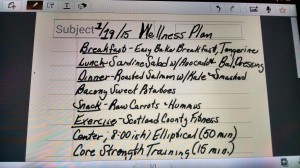You know by the date of this blog that New Year’s Day was only three weeks ago.
Were you one of the many that made a resolution to change your ways to start eating healthfully and exercise regularly? How are you doing today with that resolution? If you aren’t very happy with your willpower right now, you’ve come to the right place. I can give you some insight as to how your brain works to form any type of habit and how it is possible to trick your brain into changing that habit with select strategies. But please understand, a concrete belief by you that change is possible is MANDATORY! I say this because I have counseled clients for a number of years about changing their health patterns and I can say this without equivocation: The clients that really believed they would fail, did, and the clients that really believed they could make healthy habit changes were successful!
Okay, so let’s first get a little brain science background. The brain is an extremely efficient organ. When we first learn a new task, the brain goes into overdrive to process all of the new information, however, when that chore becomes routine, your mental activity decreases precipitously and the task is relegated to the category of “habit.” As neuroscientist David Eagleman writes in Incognito, “Brains are in the business of gathering information and steering behavior appropriately. It doesn’t matter whether consciousness is involved in the decision making. And most of the time, it’s not.”
Now there’s a reason your brain goes into this automatic mode. It allows the brain to tackle new challenges on the horizon, putting learned tasks in the brain file cabinet, ready to be called up at any moment. In The Power of Habit: Why We Do What We Do in Life and Business, writer Charles Duhigg writes, “This process—in which the brain converts a sequence of actions into an automatic routine—is known as “chunking,” and it’s at the root of how habits form. There are dozens—if not hundreds—of behavioral chunks that we rely on every day.”
Habits are formed in a three-loop process: first there is a cue, then a routine then a reward. So the gerbil wheel of cue, routine, reward, cue, routine, reward, cue, routine, reward is rolling non-stop.
The question is, can we stop the gerbil wheel and change a habit? Absolutely! The crucial change that must be made to eliminate a bad health habit is to execute a routine that is healthier to yield the same reward. Remember that your brain doesn’t know the difference between a positive and negative habit. It is your job to break that cycle with a new, healthier routine (that you believe in) that will give you a comparable reward. I will use myself as an example. Long ago, more times than I would like to admit, when I was exposed to treat food or sought out treat food (usually when I was by myself, so nobody knew), these were some of my familiar stops:
I would routinely gorge myself on those foods like there was no tomorrow and felt miserable the next day.
I replaced that routine with a healthier, more measured option. I allowed myself, every Friday and Saturday night to have one treat food, usually a small sundae with butterscotch, sprinkles and whipped cream.
So when I had a cue of unending calorie packed treats during the week, I passed them up, knowing I would have my sundae “reward” on Friday and Saturday night. This is a delayed gratification response that worked for me.
Please know this was not an overnight change for me to become healthy. I had a lot of bumps along the way on the road to health. I just wanted to share what I’ve learned from my own experience and my encounters counseling my client over the years.
Another example of breaking the habit cycle was when one of my clients had a problem with depression because her marriage had just ended and she had two little kids. She was drinking, not exercising, eating poorly and maintaining more than a full-time job at the office and at home with her kids. I gave her some nutritional advice and recommended a natural supplement for her depression. What broke the cycle of bad habits for her was when I recommended she get a babysitter for one hour after work so she could work out. I asked her to stop drinking for just a month and I also asked her to check in with me every week. Guess what? After 3 months, this lady had adopted exercise as her go-to for feeling good instead of alcohol, she was eating more healthfully and she was getting on with her life with her two little girls.
Here are my top five strategies for changing health into a habit:
1. Have a daily wellness plan in mind, taking it one day at a time. Every night briefly write down your schedule to keep you on the “health track” for the next day. Here is an example:
You’ll note I have a plan for what I’m going to eat, and the when, what and length of my exercise session the next day. I’m not saying the plan will always work, life happens, changes have to be made. However, if you start out with a plan each day, you are much more likely to stay truer to the course than veer off into the ditch. Remember also that this is a lifestyle change for your health, not a race. Taking it day by day is the best formula.
2. Avoid the booby traps BUT have your own “reward” in mind . If certain foods are your triggers and they “call you” by name, steer clear by avoiding them if you are in a public place or hide them out of site if you are at home. When you first start a healthy eating program, general avoidance is the best policy for trigger foods. You can think about portion control for your trigger foods once you have that healthy habit down pat. The same goes for exercise. If certain “friends” want you to bypass your daily exercise regimen, take a vacation from those friends for a while. However, that doesn’t mean you can’t have your own little reward. As I mentioned above, setting up a specific time for my treat foods was my little reward, so I could pass up those foods during the week. Giving yourself some special “me” time, i.e. pedicure, or a material non-food item as a reward, i.e. a new workout outfit, is also an excellent option I’ve recommended to my clients. Try re-thinking your daily exercise time as “me”/reward time for it has a multitude of benefits: it releases endorphins that make you feel good, you are modeling behavior for your family (ask my kids, they knew to never interrupt Mommy when she exercised, now, as adults they all exercise on a regular basis) and friends AND you are establishing a healthy habit!
3. “I’ll Get By With a Little Help From My Friends”- Ask your family and friends to support your healthy habit transformation. We all have down or troubled days. Put those family or friends at the top of your phone cue and call them when you want to veer off your health course. It might be that talking your problems out, instead of rewarding yourself with food, will make that healthy habit connection happen that much sooner.
4. Have a healthy inventory at your fingertips. Have a supply of healthy staples for a wholesome meal base in your home like lean proteins (cans of salmon, chicken breast, lean ground beef), broths, canned tomatoes, flavorful condiments (i.e. Dijon mustard, vinegars, soy sauce), spices, healthy oils, grains, legumes, onion and garlic. Try to plan your meals at least a day in advance, preferably 2-3 days and buy the fresh vegetables and fruit when you are out. The exercise inventory you need on hand is exercise tapes for those days when you don’t have time to workout outside the home. This would go under the category of the “no-excuse exercise zone.” I can’t tell you how many times those exercise tapes came in handy when time wouldn’t allow me to workout away from the home.
5. Have patience AND forgive your lapses.- I wouldn’t even be that concerned with the scale at this point, take a baseline weight at the beginning then take each day at a time. I promise, it’s worth the slow and steady effort. Remember this isn’t,
It’s the marathon of life, not the short sprint of life. Steadily making improvements in your wellness can lead to a life well-lived of wellness, so be kind to yourself in this healthy habit transformation process.
You are going to have some bad days and some good days. Forgive yourself when the bad days happen and you lapse into your unhealthy ways, that’s okay. Just pick yourself up, brush yourself off and get back on the healthy habit track!
Recap of My Top Five Strategies for Changing Health Into a Habit:
- Have a daily wellness plan in mind, taking it one day at a time.
- Avoid the booby traps BUT have your own “reward” in mind.
- “I’ll Get By With a Little Help From My Friends”
- Have a healthy inventory at your fingertips.
- Have patience, forgive your lapses AND BELIEVE!
I have to brag a little bit here. All three of our kids were definitely on the wrong health path at one point in their youth, just like their Mom. However, as adults, all three of our kids are on the right wellness track and this Mom couldn’t be more proud!
This is our 2014 Christmas card, “Rockin’ Around the Christmas Tree.”









[…] response, reward gerbil wheel known as behavioral chunking (for more about breaking bad habits see Strategies For Changing Health Into a Habit). In this case, continually arguing with yourself when that automatic pessimistic thought crosses […]